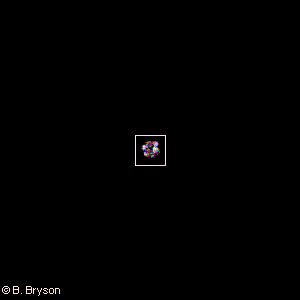Scale: 10-13 meters = 100 fm = 100 femtometers
The NucleusThe nucleus of this carbon atom contains a tightly bound group of 6 protons and 6 neutrons. C12 is the most abundant and stable isotope of carbon. Isotopes of carbon have been found or created with as few as 2 and as many as 13 neutrons. The only other stable isotope of carbon is C 13, with 7 neutrons. C13 accounts for only slightly more than 1% of the carbon atoms found in nature. C14, with 8 neutrons, is a particularly useful isotope of carbon. It is a naturally occuring radioactive isotope with a half life of 5730 years. This means that one half of a sample of C 14 will decay to an isotope of nitrogen, N 14, in 5730 years. After 11 460 years, only one quarter of the sample will be left, one eighth after 17 190 years, and so on. The upshot of this is that the amount of C 14 in fossils can be used to date the age of the fossil. Carbon dating, and similar processes using a variety of other elements, are important tools for determining the history of life on Earth. Copyright © 2016 by Bruce Bryson |
